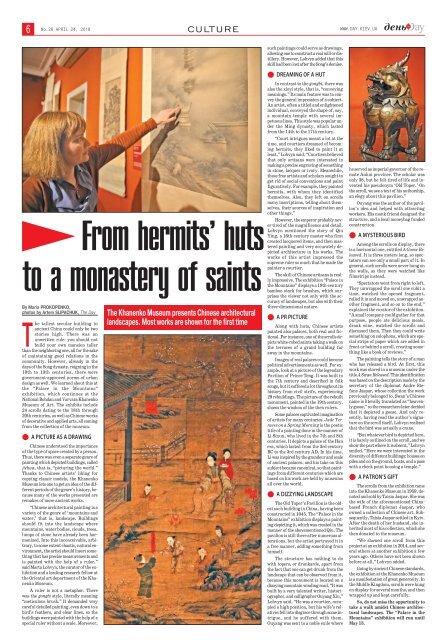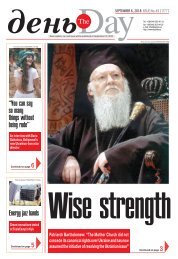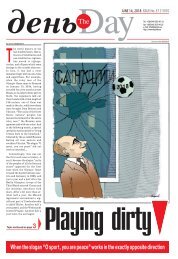26_1-8
Create successful ePaper yourself
Turn your PDF publications into a flip-book with our unique Google optimized e-Paper software.
6<br />
No.<strong>26</strong> APRIL 24, 2018<br />
CULT URE<br />
WWW.DAY.KIEV.UA<br />
From hermits’ huts<br />
to a monastery of saints<br />
By Maria PROKOPENKO,<br />
photos by Artem SLIPACHUK, The Day<br />
The tallest secular building in<br />
ancient China could only be two<br />
stories high. There was an<br />
unwritten rule: you should not<br />
build your own mansion taller<br />
than the neighboring one, all for the sake<br />
of maintaining good relations in the<br />
community. However, already in the<br />
days of the Song dynasty, reigning in the<br />
10th to 13th centuries, there were<br />
government-approved norms of urban<br />
design as well. We learned about this at<br />
the “Palace in the Mountains”<br />
exhibition, which continues at the<br />
National Bohdan and Varvara Khanenko<br />
Museum of Art. The exhibits include<br />
24 scrolls dating to the 18th through<br />
20th centuries, as well as Chinese works<br />
of decorative and applied arts, all coming<br />
from the collection of the museum.<br />
● A PICTURE AS A DRAWING<br />
Chinese understood the importance<br />
of the type of space created by a person.<br />
Thus, there was even a separate genre of<br />
painting which depicted buildings, called<br />
jiehua, that is, “picturing the world.”<br />
Thanks to Chinese artists’ liking for<br />
copying classic models, the Khanenko<br />
Museum lets one to get an idea of the different<br />
periods of the genre’s history, because<br />
many of the works presented are<br />
remakes of more ancient works.<br />
“Chinese architectural painting is a<br />
variety of the genre of ‘mountains and<br />
water,’ that is, landscape. Buildings<br />
should fit into the landscape where<br />
mountains, water bodies, clouds, trees,<br />
lumps of stone have already been harmonized.<br />
Into this inconceivable, arbitrary,<br />
to some extent chaotic, natural environment,<br />
the artist should insert something<br />
that has precise measurements and<br />
is painted with the help of a ruler,”<br />
said Marta Lohvyn, the curator of the exhibition<br />
and a leading research fellow at<br />
the Oriental art department of the Khanenko<br />
Museum.<br />
A ruler is not a metaphor. There<br />
was the gongbi style, literally meaning<br />
“meticulous brush.” It demanded very<br />
careful detailed painting, even down to a<br />
bird’s feathers, and clear lines, so the<br />
buildings were painted with the help of a<br />
special ruler without a scale. Moreover,<br />
The Khanenko Museum presents Chinese architectural<br />
landscapes. Most works are shown for the first time<br />
such paintings could serve as drawings,<br />
allowing one to constructareal mill or distillery.<br />
However, Lohvyn added that this<br />
skill had been lost after the Song’s demise.<br />
● DREAMING OF A HUT<br />
In contrast to the gongbi, there was<br />
also the xieyi style, that is, “conveying<br />
meanings.” Its main feature was to convey<br />
the general impression of a subject.<br />
An artist, often a titled and enlightened<br />
individual, conveyed the shape of, say,<br />
a mountain temple with several impetuous<br />
lines. This style was popular under<br />
the Ming dynasty, which lasted<br />
from the 14th to the 17th century.<br />
“Court intrigues meant a lot at the<br />
time, and courtiers dreamed of becoming<br />
hermits, they liked to paint it at<br />
least,” Lohvyn said. “Courtiers believed<br />
that only artisans were interested in<br />
making a precise engraving of something<br />
in stone, lacquer or ivory. Meanwhile,<br />
these free artists and scholars sought to<br />
get rid of social conventions and paint<br />
figuratively. For example, they painted<br />
hermits, with whom they identified<br />
themselves. Also, they left on scrolls<br />
many inscriptions, telling about themselves,<br />
their sources of inspiration and<br />
other things.”<br />
However, the emperor probably never<br />
tired of the magnificence and detail.<br />
Lohvyn mentioned the story of Qiu<br />
Ying, a 16th-century master who first<br />
created lacquered items, and then mastered<br />
painting and very accurately depicted<br />
architecture in his works. The<br />
works of this artist impressed the<br />
supreme ruler so much that he made the<br />
painter a courtier.<br />
The skill of Chinese artisans is really<br />
impressive. The exhibition “Palace in<br />
the Mountains” displays a 19th-century<br />
bamboo stack for brushes, which surprises<br />
the viewer not only with the accuracy<br />
of landscapes, but also with their<br />
three-dimensional nature.<br />
● A PR PICTURE<br />
Along with huts, Chinese artists<br />
painted also palaces, both real and fictional.<br />
For instance, one of the scrolls depicts<br />
white-robed saints taking a walk on<br />
the terraces of a grand building far<br />
away in the mountains.<br />
Images of real palaces could become<br />
political advertisements as well. For example,<br />
look at a picture of the legendary<br />
Pavilion of Prince Teng. It was built in<br />
the 7th century and described in folk<br />
songs, but it suffered a lot throughout its<br />
history from civil strife, experiencing<br />
29 rebuildings. The picture of the rebuilt<br />
monument, painted in the 19th century,<br />
shows the wisdom of the then rulers.<br />
Some palaces captivated imagination<br />
of artists for many centuries. Jade Terraces<br />
on a Spring Morning is the poetic<br />
title of a painting done in the manner of<br />
Li Sixun, who lived in the 7th and 8th<br />
centuries. It depicts a palace of the Han<br />
era, which lasted from the 3rd century<br />
BC to the 3rd century AD. In his time,<br />
Li was inspired by the grandeur and scale<br />
of ancient palaces, and his take on this<br />
subject became canonical, so that paintings<br />
from different centuries which are<br />
based on his work are held by museums<br />
all over the world.<br />
● A DIZZYING LANDSCAPE<br />
The Old Toper’s Pavilion is the oldest<br />
such building in China, having been<br />
constructed in 1045. The “Palace in the<br />
Mountains” exhibition displays a painting<br />
depicting it, which was created in the<br />
manner of the abovementioned Qiu. The<br />
pavilion is still there after numerous alterations,<br />
but the artist portrayed it in<br />
a free manner, adding something from<br />
himself.<br />
The structure has nothing to do<br />
with topers, or drunkards, apart from<br />
the fact that one can get drunk from the<br />
landscape that can be observed from it,<br />
because this monument is located on a<br />
dizzying mountain winding road. “It was<br />
built by a very talented writer, historiographer,<br />
and calligrapher Ouyang Xiu,”<br />
Lohvyn said. “He was a courtier, occupied<br />
a high position, but his wife’s relatives<br />
fell into disgrace through some intrigue,<br />
and he suffered with them.<br />
Ouyang was sent to a noble exile where<br />
he served as imperial governor of the remote<br />
Anhui province. The scholar was<br />
only 38, but he felt tired of life and invented<br />
his pseudonym ‘Old Toper.’ On<br />
the scroll, we see a text of his authorship,<br />
an elegy about this pavilion.”<br />
Ouyang was the author of the pavilion’s<br />
idea and helped with attracting<br />
workers. His monk friend designed the<br />
structure, and a local moneybag funded<br />
construction.<br />
● A MYSTERIOUS BIRD<br />
Among the scrolls on display, there<br />
is a horizontal one, entitled A Goose Released.<br />
It is three meters long, so spectators<br />
can see only a small part of it. In<br />
general, such scrolls were never hung on<br />
the walls, as they were watched like<br />
filmstrips instead.<br />
“Spectators went from right to left.<br />
They unwrapped the scroll one cubit a<br />
time, watched the opened fragment,<br />
rolled it in and moved on, unwrapped another<br />
fragment, and so on to the end,”<br />
explained the curator of the exhibition.<br />
“A small company could gather for that<br />
purpose, people ate delicious meals,<br />
drank wine, watched the scrolls and<br />
discussed them. Then they could write<br />
something on colophons, which are special<br />
strips of paper which are added in<br />
front or behind a scroll, creating something<br />
like a book of reviews.”<br />
The painting tells the story of a man<br />
who has released a bird. At first, this<br />
work was stored in a museum under the<br />
title A Swan Released. This identification<br />
was based on the description made by the<br />
secretary of the diplomat Andre Stefane<br />
Jaspar, whose collection the work<br />
previously belonged to. Swan’s Chinese<br />
name is literally translated as “heavenly<br />
goose,” so the researchers later decided<br />
that it depicted a goose. And only recently,<br />
having read the author’s signature<br />
on the scroll itself, Lohvyn realized<br />
that the bird was actually a crane.<br />
“But whatever bird is depicted here,<br />
it is barely outlined on the scroll, and we<br />
show the part where it is absent,” Lohvyn<br />
smiled. “Here we were interested in the<br />
diversity of different buildings: houses on<br />
piles and on the ground, boats, and a pass<br />
with a check point housing a temple.”<br />
● A PATRON’S GIFT<br />
The scrolls from the exhibition came<br />
into the Khanenko Museum in 1959, donated<br />
and sold by Taisia Jaspar. She was<br />
the wife of the aforementioned Chinabased<br />
French diplomat Jaspar, who<br />
owned a collection of Chinese art. Subsequently,<br />
Taisia Jaspar settled in Kyiv.<br />
After the death of her husband, she inherited<br />
most of his collection, which she<br />
then donated to the museum.<br />
“We showed one scroll from this<br />
project at an exhibition in 2014, and several<br />
others at another exhibition a few<br />
years ago. Others have not been shown<br />
before at all,” Lohvyn added.<br />
Going by ancient Chinese standards,<br />
the exhibition at the Khanenko Museum<br />
is a manifestation of great generosity. In<br />
the Middle Kingdom, scrolls were hung<br />
on display for several months, and then<br />
wrapped up and kept carefully.<br />
So, do not miss the opportunity to<br />
take a walk amidst Chinese architectural<br />
landscapes. The “Palace in the<br />
Mountains” exhibition will run until<br />
May 13.

















